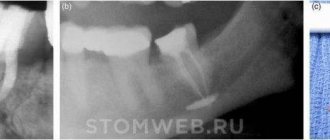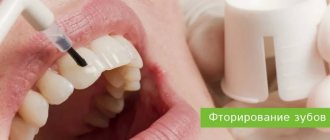Teeth have a special coating called enamel. It performs a protective function, protecting soft parts from the penetration of bacteria into them, and also prevents the possibility of mechanical damage. With improper dental care, a process called demineralization develops. It represents a decrease in the amount of essential salts and minerals in the enamel, which ultimately leads to disruption of its structure. To prevent the occurrence of negative consequences from this process, dentistry has a special procedure - remineralization of teeth. With its help, it is possible to restore thinned enamel, which is successfully implemented only in the initial stages of the development of pathology.
Remineralization of teeth - what is this process?
The porosity of the enamel allows the free passage of acids into the enamel layer, which leads to the leaching of useful minerals. This is a normal process that occurs continuously in a healthy body. Minerals washed out by acids are replenished with new elements, which ensures the maintenance of the optimal composition of the enamel.
If the acid-base balance is disturbed, then the development of the demineralization process is observed. The amount of minerals washed out by acids is actively decreasing, and their composition is not replenished. The procedure for remineralization of teeth is carried out to restore the quality of tooth enamel, that is, the missing amount of mineral substances is replenished.
Is it possible to restore enamel on teeth, what can you use to restore a beautiful smile?
The only and most reliable way is to go to a good dental clinic, where the doctor will carry out complex fluoridation, installation of veneers or lumineers.
Only this gives a 100% guarantee that the top layer will be reliably protected from further damage, and the health of the oral cavity will not be threatened. All other options can be used to maintain microflora and the integrity of the protective shell. They can only partially help make the thinned area stronger, but this will take a lot of time, during which, if hygiene is insufficient, bacteria can infect the tissue.
Restoring tooth enamel at home
Dental specialists can suggest several recipes to help maintain oral health:
- Sea salt. 4 tablespoons are diluted in a glass of water, the resulting essence is used for cleaning with a brush or applied in the form of lotions. Salt crystals can be mixed with oil and applied to the crown to reduce sensitivity.
- Rinse with soda solution.
- Application of propolis extract. To enhance the effect, calamus is added to it.
- Herbal decoctions also help in strengthening and improving the color of dental plates.
Remember that even if you know how to restore tooth enamel using traditional recipes, they are only permissible in cases of mild damage; in other cases, only a visit to the dentist will save you.
Diet to restore the protective shell
Nutrition is the basis of everything. The health of all organs and systems of the body begins with a proper diet, teeth are no exception. There are several rules that will help in regenerating the outer layer with minor defects:
- consume dairy products, nuts, seeds, fruits and vegetables high in potassium;
- eliminate fast carbohydrates from the diet;
- soda should be replaced with plain water;
- eat more fish dishes, eggs, mushrooms, legumes, liver, red meat.
The basis for a beautiful smile can be considered foods high in calcium, phosphorus, fluorine, vitamin D, C and B6.
Enamel restoring pastes
Remember that all products purchased at a pharmacy or in stores have a huge concentration of active substances. Therefore, if your dentist did not prescribe this remedy, you can cope without them.
However, in some cases they use:
- Calcined compounds “Biocalcium” from Splat, “President Unique” “Pomorin Maximum Protection”.
- Fluoridated pastes “Herbal Complete” and “Siberian Berries” from Splat. The Colgate Elmex series is also suitable.
The second means is with fluoride; it is not recommended to use it if there are any inflammatory processes in the oral cavity.
Gels
This form of release is convenient because the gel-like texture adheres to the gums and surface of the teeth beyond antiseptic solutions. Remineralizing agents used in dental practice include:
- Tooth Mousse - based on goat milk, calcium and phosphorus ions. Active components penetrate damaged areas, fill them and restore the integrity of the layer.
- Global White Gel - replenishes the lack of minerals, potassium nitrate reduces sensitivity, and D-panthenol eliminates dryness and has an antiseptic effect.
- Asepta - propolis in the composition helps restore the vitamin-mineral complex of the tooth; the wax base allows the product to remain on the gums and enamel longer.
Before purchasing any medicinal gels, you should consult your doctor.
Mouthguards
Such designs involve the use of long-term use creams. A thin layer of a medicinal agent is applied to the inner part, then fixed on the dentition.
This is due to the fact that when a gel-like or creamy texture is applied, increased salivation begins and the drugs are washed out of the cavity. The mouthguard protects against this process, allowing the active components to remain on the teeth for as long as prescribed in the instructions or recommended by the dentist.
Hydroxyapatite
It easily fills gaps, chips and cracks, integrates into the crystal structure, and regenerates its integrity. Included in Apadent, Apagard, Biorepair, Miradent pastes.
It is recommended to use them after every meal or at least twice a day. Apply with a soft brush that will not cause mechanical damage.
Regular use helps eliminate incipient caries, which is at the “white spot” stage. Also, increased sensitivity to hot and cold drinks and food almost completely disappears.
Theobromine
No matter how chocolate is considered the main enemy of a beautiful smile, an amazing active component was found in cocoa beans that promotes the rapid regeneration of enamel. Moreover, the product is several times more effective than fluoride used in dentistry. Now it is used in the production of pastes, for example, THEODENT.
You can order it on the official website with delivery from the USA, you can choose a classic version or with a higher content of the substance. Partial restoration of tooth enamel at home is possible using this advanced method, however, it is better to use it only after consultation with a specialist.
Causes of demineralization
Acids entering the oral cavity contribute to the leaching of beneficial minerals, which leads to the development of the demineralization process. However, after eating food in a healthy body, their quantity is restored. If malfunctions occur in the human body, for example, plaque forms on the teeth due to insufficient care, then the acidity balance is disturbed, which entails the development of pathology. The most common causes of the process of demineralization of tooth enamel include the following:
- Hygiene is not maintained - teeth brushing should be done 2 times a day, and its duration should be at least 2 minutes. After eating food, it is recommended to rinse the mouth with special preparations or plain water.
- Nutritional imbalance - if the diet contains a lot of carbohydrates and there is an insufficient supply of minerals.
- Consuming a large number of acid-containing foods, which include not only citrus fruits, but also various carbonated drinks.
- Metabolic disorders or hormonal imbalances in the body that occur against the background of various factors: pregnancy, stress, adolescence, etc.
- Bad habits - in particular, smoking contributes to the active development of the demineralization process.
- Bleaching of enamel, which ultimately can also lead to the leaching of mineral substances and, as a result, cause the development of pathology. This procedure must be carried out by an experienced professional, and after it is performed, the patient must follow strict hygiene rules.
- Wearing dentures and braces - failure to follow the rules of care leads to damage to the enamel.
In order to detect dental diseases in a timely manner, you only need to regularly visit the dental office for preventive examinations.
Diagnosis of the disease
Diagnosis of suspected demineralization comes down to the following procedures:
- Inspection . The doctor cleans the teeth of plaque and dries them. The presence of white matte spots on the teeth indicates pathology.
- Enamel staining . The doctor stains the cleaned and dried teeth with blue dye. Unlike healthy areas, areas of demineralization are stained. Moreover, the brighter the shade, the more serious the damage to the enamel.
- Application of ultraviolet light . When teeth are illuminated with ultraviolet light, healthy areas glow blue, while damaged areas glow dark.
- Using a laser . The method is based on the fact that areas with different mineralization reflect laser waves of different lengths.
The remineralization process: how it is carried out
Remineralization allows you to restore the quality of enamel by filling it with important trace elements. In this case, hard tissues are strengthened. Due to all this, the sensitivity of teeth (to cold, hot) is ultimately reduced, and the likelihood of developing caries will be much lower.
A professional procedure is carried out by treating teeth with special preparations that contain the necessary mineral components: usually calcium, magnesium, phosphorus, fluorine. They are left on the teeth for several minutes until the enamel is completely saturated. The technique includes the following steps:
- Teeth cleaning.
- Treat them with a 1% hydrogen peroxide solution, followed by drying.
- Applying tampons with a 10% solution of calcium gluconate, which are applied for 20 minutes and changed every 5 minutes.
- The final stage is an application of sodium fluoride for 5 minutes.
Important! Sometimes electrophoresis is used to speed up the remineralization procedure.
Treatment involves completing an appropriate course (15-20 sessions), since one procedure does not achieve the desired result. In order to avoid the recurrence of problems with the development of pathology in the future, you need to regularly visit the dentist and, if necessary, immediately restore the thinned layer of tooth enamel.
What is remineralization therapy
The remineralization therapy technique involves applying specialized compounds to the surface of tooth enamel that restore the structure. Usually we are talking about drugs based on fluorine, calcium, phosphates and other useful components.
In dentistry, rem therapy is performed in several ways:
- An express method, the essence of which is to put on disposable mouth guards filled with gel with a fluoride-containing base;
- Application of specialized varnishes that eliminate minor damage and restore the enamel structure;
- Reusable trays for remineralization at home.
The duration of such therapy depends on the degree of damage to the enamel, but usually several sessions are enough to achieve the expected result. Remineralizing dental therapy is a unique and affordable technique, but such treatment is carried out only in combination.
Pros and cons of performing the procedure
If you resort to teeth remineralization in a timely manner, the effect will be maximum. Among the advantages of the procedure:
- Absolute harmlessness, safety and painlessness.
- Quick and reliable restoration of the integrity of the tooth coating (enamel).
- Prevention of the development of oral diseases.
Remotherapy is prescribed not only to adults, but also to children. After all, the condition of the baby teeth determines what the permanent teeth will be like.
There are practically no disadvantages of remineralization. The choice of means depends on the individual characteristics of the body. The effectiveness of the procedure is associated not only with the drugs chosen for its implementation, but also with the correctness of the preparatory work (teeth cleaning and sanitation).
Effect after remotherapy
Remotherapy is an absolutely painless procedure. No anesthesia is required. Remineralization is safe and can be carried out during pregnancy, prescribed to children to strengthen the enamel of baby teeth and as the main means of caries prevention. Remotherapy can reduce tooth sensitivity, improve the structure of the enamel, making it denser, stronger and more resistant to acids and other aggressive substances.
In combination with other methods of prevention, such as fissure sealing, fluoridation and ozone therapy, remotherapy can reduce the risk of developing a carious process to zero. Often, along with dental treatment, gum treatment and diet correction with medications and vitamins are required. In addition, remotherapy is necessarily carried out after teeth whitening and orthodontic treatment procedures. Remotherapy is also necessary for pregnant women and adolescents.
Indications and contraindications for
Indications for remineralization are the following factors:
- Identifying signs of demineralization.
- Increased sensitivity of teeth to food, hot and cold.
- Plaque on the teeth.
- Sensitivity appears after teeth whitening or tartar removal.
Remineralization is a virtually harmless and safe procedure that has no contraindications. It is prohibited in one case, when the patient has an individual intolerance to the drugs used for therapy.
To keep your teeth healthy, it is important not only to maintain oral hygiene, but also to regularly visit the dental office. This will make it possible to identify diseases in the early stages and prevent their development using simple, safe, reliable and inexpensive procedures.
Focal demineralization of tooth enamel, photo
Above we described what focal demineralization of teeth looks like. Photos of patients with this pathology will be presented below. At the initial stage, focal demineralization can affect one or a small number of teeth; it is weakly expressed and often does not attract the patient’s attention at all.
Focal demineralization in adults is characterized by the extensiveness of the process - it is not uncommon that at the initial stage an entire row of teeth can be affected.
Demineralization of teeth, the photo of which is on the left, becomes more and more pronounced in the absence of treatment - the spots change their color from white to light, and then dark brown. Subsequently, focal demineralization ends with the formation of carious cavities.
What to do with a thin protective shell
In case of damage or genetic predisposition, there is no need to be upset. We will have to strengthen control and care of the oral cavity in order to prevent the development of pathological processes and long-term treatment, but there is nothing terrible about it. Follow a few basic principles that will help keep your smile beautiful and your teeth healthy:
- stop eating solid foods;
- visit the dentist at least once every six months;
- carry out professional fluoridation;
- use remineralizing agents twice a day as prescribed by your doctor;
- stick to a diet, eat more vegetables, fruits and healthy foods.
To prolong the beauty of a smile, it is enough to increase attention and care. This will not take much time, but will prevent further tooth thinning and damage.
Is it possible to completely restore enamel on your own?
Contrary to the fact that many want to see a positive answer in this section, there will not be one. If the coating began to deteriorate, then there were contributing factors, which do not always depend on whether the person cracked nuts with his teeth or not. You can only partially slow down this process before you can visit the dentist’s office and take drastic measures.
For protection, doctors offer the thinnest veneers. They are not felt in the mouth, do not bring the slightest discomfort, but at the same time, ceramics prevent microorganisms from reaching the protective shell and penetrating deep into the crown. In addition, the doctor can coat the dental plates with a fluoridating or remineralizing composition, which will prevent destruction for a long time. Therefore, to the question: how and whether it is possible to restore enamel on teeth at all, the answer will only be denial.
What causes increased tooth sensitivity?
Tooth enamel is one of the strongest tissues in the body. It consists of 98% microelements. It is believed that if it gets on a tooth, even a product made of Damascus steel can become dull. However, often the strength of dental tissue may not be enough to last a lifetime. Normally, the processes of strengthening enamel (remineralization) and loosening it (demineralization) are balanced. If for some reason the process of leaching of trace elements begins in the body, then they speak of demineralization. At the same time, microelements that ensure its strength are washed out of the bone tissue (calcium, magnesium, potassium, phosphorus, fluorine, potassium, etc.)
Causes of demineralization
Normally, the mineralization of dental tissue is significantly higher than the mineralization of bone tissue. The increased hardness of tooth enamel is associated with its composition, when the calcium compound is protected by the presence of other microelements. Excess or lack of trace elements in the body also causes dental problems. One of the main “guardians” of tooth enamel is fluoride, which protects calcium from dissolution and leaching. However, as fluoride levels increase, tooth enamel also begins to darken and erode (fluorosis).
What needs to happen to the body for tooth enamel to begin to lose its former strength? Typically, tooth decay in the body is provoked by the same reasons that cause the destruction of bone tissue. Often this process is associated with a violation of the supply or absorption of essential minerals in the body, especially calcium and phosphorus. Metabolic failure in the body can occur when absorption is impaired at one of the levels. This may be due to reasons related to:
- excessive consumption of sugars;
- malabsorption in the intestine;
- impaired digestion of food (with celiac disease, dysbacteriosis);
- diseases of the endocrine system associated with metabolic disorders (diseases of the thyroid gland or adrenal glands, diabetes mellitus, etc.);
- lack of enzymatic activity that increases the absorption of minerals.
In addition to general disorders in the body, mineralization disorders can occur when:
- poor dental hygiene;
- dental crowding;
- inflammation of the gums;
- improper use of orthodontic structures.
All of the above diseases and situations contribute to the softening of the enamel and can lead to its complete destruction.
Prevention
To prevent demineralization and after remineralization, careful oral hygiene is important: brushing teeth, rinsing with pharmaceutical rinses, using dental floss, a balanced diet, limiting coffee and sweet foods, avoiding smoking. In any case, visiting the dentist 2 times a year is simply necessary.
Despite all the effectiveness of remineralization, this method of tooth restoration is used at the initial stage of demineralization (when white spots appear). If the destruction of tooth enamel has acquired an advanced form, then the patient is unlikely to be able to avoid a drill or prosthetics. Take care of your teeth!
Sources used:
- Prevention of caries in the pits and fissures of teeth / T.V. Popruzhenko. - M.: MEDpress-inform, 2010.
- Prevention of inflammatory periodontal diseases. Textbook / A.I. Abdurakhmanov et al. - M.: GEOTAR-Media, 2015.
- Professional prevention in dental practice / Jean-François Roulet, Stefan Zimmer. - M.: MEDpress-inform, 2010.
- Fejerskov, O., Nyvad, Bente, & Kidd, Edwina A. M. (2015). Dental caries: The disease and its clinical management (Third ed.)
- St. Petersburg State Pediatric Medical University










